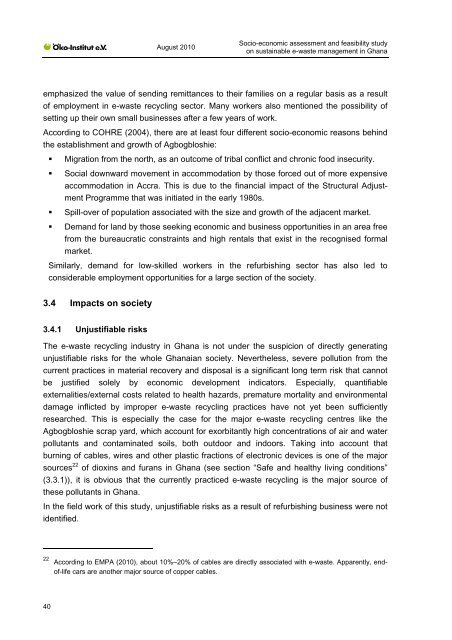Socio-economic assessment and feasibility study on - Öko-Institut eV
Socio-economic assessment and feasibility study on - Öko-Institut eV
Socio-economic assessment and feasibility study on - Öko-Institut eV
Create successful ePaper yourself
Turn your PDF publications into a flip-book with our unique Google optimized e-Paper software.
40<br />
August 2010<br />
<str<strong>on</strong>g>Socio</str<strong>on</strong>g>-<str<strong>on</strong>g>ec<strong>on</strong>omic</str<strong>on</strong>g> <str<strong>on</strong>g>assessment</str<strong>on</strong>g> <str<strong>on</strong>g>and</str<strong>on</strong>g> <str<strong>on</strong>g>feasibility</str<strong>on</strong>g> <str<strong>on</strong>g>study</str<strong>on</strong>g><br />
<strong>on</strong> sustainable e-waste management in Ghana<br />
emphasized the value of sending remittances to their families <strong>on</strong> a regular basis as a result<br />
of employment in e-waste recycling sector. Many workers also menti<strong>on</strong>ed the possibility of<br />
setting up their own small businesses after a few years of work.<br />
According to COHRE (2004), there are at least four different socio-<str<strong>on</strong>g>ec<strong>on</strong>omic</str<strong>on</strong>g> reas<strong>on</strong>s behind<br />
the establishment <str<strong>on</strong>g>and</str<strong>on</strong>g> growth of Agbogbloshie:<br />
� Migrati<strong>on</strong> from the north, as an outcome of tribal c<strong>on</strong>flict <str<strong>on</strong>g>and</str<strong>on</strong>g> chr<strong>on</strong>ic food insecurity.<br />
� Social downward movement in accommodati<strong>on</strong> by those forced out of more expensive<br />
accommodati<strong>on</strong> in Accra. This is due to the financial impact of the Structural Adjustment<br />
Programme that was initiated in the early 1980s.<br />
� Spill-over of populati<strong>on</strong> associated with the size <str<strong>on</strong>g>and</str<strong>on</strong>g> growth of the adjacent market.<br />
� Dem<str<strong>on</strong>g>and</str<strong>on</strong>g> for l<str<strong>on</strong>g>and</str<strong>on</strong>g> by those seeking <str<strong>on</strong>g>ec<strong>on</strong>omic</str<strong>on</strong>g> <str<strong>on</strong>g>and</str<strong>on</strong>g> business opportunities in an area free<br />
from the bureaucratic c<strong>on</strong>straints <str<strong>on</strong>g>and</str<strong>on</strong>g> high rentals that exist in the recognised formal<br />
market.<br />
Similarly, dem<str<strong>on</strong>g>and</str<strong>on</strong>g> for low-skilled workers in the refurbishing sector has also led to<br />
c<strong>on</strong>siderable employment opportunities for a large secti<strong>on</strong> of the society.<br />
3.4 Impacts <strong>on</strong> society<br />
3.4.1 Unjustifiable risks<br />
The e-waste recycling industry in Ghana is not under the suspici<strong>on</strong> of directly generating<br />
unjustifiable risks for the whole Ghanaian society. Nevertheless, severe polluti<strong>on</strong> from the<br />
current practices in material recovery <str<strong>on</strong>g>and</str<strong>on</strong>g> disposal is a significant l<strong>on</strong>g term risk that cannot<br />
be justified solely by <str<strong>on</strong>g>ec<strong>on</strong>omic</str<strong>on</strong>g> development indicators. Especially, quantifiable<br />
externalities/external costs related to health hazards, premature mortality <str<strong>on</strong>g>and</str<strong>on</strong>g> envir<strong>on</strong>mental<br />
damage inflicted by improper e-waste recycling practices have not yet been sufficiently<br />
researched. This is especially the case for the major e-waste recycling centres like the<br />
Agbogbloshie scrap yard, which account for exorbitantly high c<strong>on</strong>centrati<strong>on</strong>s of air <str<strong>on</strong>g>and</str<strong>on</strong>g> water<br />
pollutants <str<strong>on</strong>g>and</str<strong>on</strong>g> c<strong>on</strong>taminated soils, both outdoor <str<strong>on</strong>g>and</str<strong>on</strong>g> indoors. Taking into account that<br />
burning of cables, wires <str<strong>on</strong>g>and</str<strong>on</strong>g> other plastic fracti<strong>on</strong>s of electr<strong>on</strong>ic devices is <strong>on</strong>e of the major<br />
sources 22 of dioxins <str<strong>on</strong>g>and</str<strong>on</strong>g> furans in Ghana (see secti<strong>on</strong> “Safe <str<strong>on</strong>g>and</str<strong>on</strong>g> healthy living c<strong>on</strong>diti<strong>on</strong>s”<br />
(3.3.1)), it is obvious that the currently practiced e-waste recycling is the major source of<br />
these pollutants in Ghana.<br />
In the field work of this <str<strong>on</strong>g>study</str<strong>on</strong>g>, unjustifiable risks as a result of refurbishing business were not<br />
identified.<br />
22<br />
According to EMPA (2010), about 10%–20% of cables are directly associated with e-waste. Apparently, endof-life<br />
cars are another major source of copper cables.

















